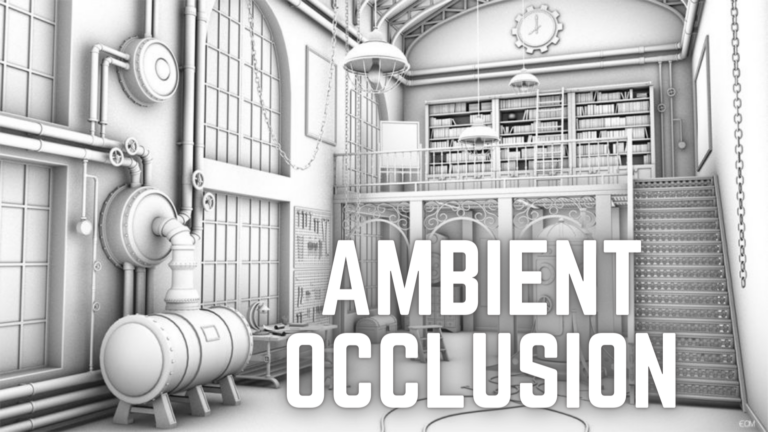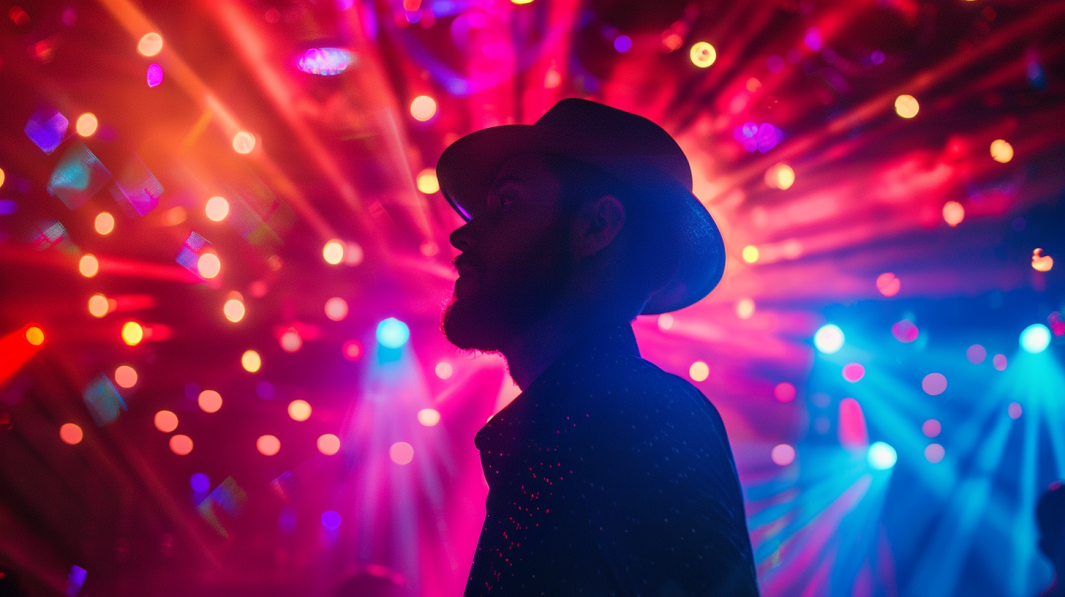Ambient Occlusion (AO) is the secret ingredient that breathes life into computer graphics. Imagine it as the artist’s delicate brushstroke, adding depth and dimension to those hidden corners and crevices where light often forgets to shine.
It’s the magic that transforms flat images into dynamic landscapes, making every shadow, corner, and edge come alive with realism. For artists and developers like me, adding a dash of AO is like seasoning a dish—it just elevates the whole experience.
And the beauty of AO doesn’t stop there. It seamlessly collaborates with other shading marvels, such as normal mapping and diffuse lighting, creating a symphony of visuals.
To put it simply, while other techniques get the limelight, AO works silently in the background, ensuring every graphic not only looks good but feels incredibly real. It’s truly the unsung maestro of the digital art world!
What Makes It Special?
AO is special due to its unique set of features.
Universal Appeal
AO is the great equalizer in graphics. Whether it’s the protagonist of a game, a simple prop, or a sprawling digital landscape, AO ensures everything shines in its best light, adding a layer of sophistication and realism.
Beyond Flatness
Flat graphics are a thing of the past with AO. It breathes life into scenes, transforming them from 2D sketches into 3D masterpieces.
The depth it adds makes every scene come alive, offering a more realistic viewing experience.
The Spotlight Effect
Every artist wants their creation to stand out. AO ensures that every detail, no matter how minute, gets its moment in the spotlight.
It accentuates the nuances, ensuring they don’t get lost in the grandeur of the scene.
Feeling the Scene
Graphics aren’t just about visuals. They’re about creating an experience.
AO crafts an ambiance, ensuring viewers don’t just see the scene but feel it, becoming a part of the story.
Different AO Algorithms
The world of AO is vast, with a plethora of algorithms at one’s disposal. Each algorithm boasts its unique strengths and potential drawbacks.
Screen-space Ambient Occlusion (SSAO)
When it comes to striking a balance between simplicity and efficiency, SSAO emerges as the preferred choice. This algorithm operates by sampling the scene directly from the screen space, making it particularly well-suited for real-time applications.
One of its major advantages is its speed, ensuring quick and efficient real-time rendering. However, every silver lining has a cloud, and for SSAO, it’s the potential for noisy or grainy visuals due to its inherent simplicity.
Hierarchical Ambient Occlusion (HBAO)
HBAO elevates the concept of ambient occlusion by introducing a layer of sophistication. Unlike SSAO, HBAO delves deeper by taking into account the depth of objects within a scene.
This depth consideration results in a more refined AO effect, producing smoother and more accurate visuals than what SSAO can offer. But this sophistication doesn’t come without its demands.
HBAO tends to be more resource-hungry, requiring greater computational power compared to its simpler counterpart, SSAO.
High-definition Ambient Occlusion (HDAO)
Enter HDAO, a relatively recent entrant in the AO world, which builds upon the principles of HBAO. What sets HDAO apart is its utilization of a higher-resolution depth buffer.
This enhancement ensures that the algorithm provides a level of accuracy that’s a cut above the rest, making it an ideal choice for projects where precision is paramount. However, with greater detail comes greater responsibility.
HDAO’s intricate approach means it often demands more resources than both SSAO and HBAO.
Voxel Cone Tracing Ambient Occlusion (VXAO)
VXAO stands at the zenith of AO algorithms. Rooted in physical principles, VXAO operates by tracing rays through a voxelized representation of the scene.
This method’s strength lies in its ability to deliver an AO effect that’s second to none in terms of accuracy. However, such precision doesn’t come easy.
VXAO is a computational powerhouse, and its demand for resources is significant, making it essential for artists and developers to have robust hardware to harness its full potential.
Choosing the Perfect AO Algorithm
Every project has unique demands. While real-time applications might lean towards SSAO for its efficiency, projects that can afford more rendering time and prioritize detail might opt for HBAO or HDAO.
Factors Shaping AO’s Visuals
The choice of algorithm is just the beginning. Several factors influence AO’s final look:
- Sampling Rate: Think of it as the resolution of AO. A higher rate captures more detail but demands more resources.
- Radius: This determines the area size considered for each AO sample. A larger radius can capture broader shadows.
- Bias: To ensure AO doesn’t overly darken a scene, a bias value is added. It’s like the safety net, preventing visuals from becoming too gloomy.
Factors Influencing AO Appearance
Beyond the choice of algorithm, several other elements play a role in determining AO’s final appearance:
- Sampling Rate: Dictates the number of samples taken per pixel.
- Radius: Specifies the size of the area under consideration for each sample.
- Bias: A supplementary value added to the AO to prevent excessive darkening.
The Many Perks of Using AO
Realism at its Best: AO acts as the bridge between the virtual and the real. By adding layers of shadow and depth, it ensures that scenes don’t just look good on screen but feel palpably real, making viewers forget they’re looking at computer graphics.
Detail-Oriented Approach: In graphics, the devil is in the details. AO ensures that even the tiniest of details, often overlooked, are brought to the forefront, making every element pop and resonate with viewers.
Crafting the Mood: Beyond the visual appeal, graphics have the power to tell stories and evoke emotions. AO, with its depth and shadow play, can set the tone of a scene, whether it’s the serenity of a tranquil forest or the tension of a looming storm.
Versatility Unleashed: AO isn’t just for a specific character or backdrop. Its magic extends to every element within a scene. From the lead character to the smallest prop, AO ensures everything is showcased in its best light.
Simplicity in Complexity: While the results of AO are undeniably intricate and detailed, the technique itself is accessible. With the right tools and knowledge, artists can harness the power of AO to create breathtaking visuals with relative ease.
The Challenges AO Presents
- High Demands: Every masterpiece demands its price. AO, with its focus on depth and detail, can be taxing on computational resources. Especially in scenes brimming with details, the demands can escalate, requiring robust hardware to render efficiently.
- Chasing Perfection: AO aims for the pinnacle of visual perfection. However, like any technique, it’s not immune to challenges. There might be instances where the results are grainy or noisy, especially in complex scenes or with certain algorithms.
- Melding Techniques: AO is a powerhouse in shading. But when it comes to integrating it with other shading techniques, the process can be intricate. Artists need to ensure that AO complements other methods, creating a cohesive and harmonious visual experience.
FAQ
How does AO differ from other shading techniques?
While many shading techniques focus on direct lighting effects, AO emphasizes the subtle shadows in areas where indirect lighting occurs. It works in harmony with other shading methods but specializes in capturing the nuances of light occlusion.
Why might an artist choose SSAO over other AO algorithms?
SSAO is favored for its simplicity and efficiency, making it ideal for real-time applications. However, it’s worth noting that while it’s quick, it might sometimes produce noisier results compared to more sophisticated algorithms.
Can AO be used in both 2D and 3D graphics?
While AO is primarily associated with 3D graphics to add depth and realism, it can also be applied in 2D scenarios to give a sense of depth and layered shadowing, enhancing the perception of three-dimensionality.
Are there any common misconceptions about AO?
One common misconception is that AO is solely about darkening images. In reality, while it does add shadows, its primary goal is to enhance depth and realism, making graphics more lifelike.
How resource-intensive is the VXAO algorithm compared to others?
VXAO is one of the most resource-intensive AO algorithms. It offers unparalleled accuracy by tracing rays through a voxelized scene representation.
While it provides exceptional results, it demands significant computational resources, making it more suited for projects where precision is paramount and resources are abundant.
Bottom Line
Ambient Occlusion (AO) is the unsung maestro of computer graphics, weaving magic into every pixel. It’s like the artist’s brush, adding depth and shadow where light doesn’t naturally fall, making scenes burst with life.
While it seamlessly collaborates with other shading techniques, its true prowess lies in its vast array of algorithms. From the efficient SSAO to the intricate VXAO, each has its unique flair, catering to different needs.
Yet, like all great things, AO comes with its challenges. It’s a hungry beast, demanding computational power, and sometimes, its pursuit of perfection might lead to minor visual hiccups.
But, when wielded right, AO transforms the mundane into masterpieces, making it an invaluable asset in the digital artistry realm. In essence, AO is the heartbeat of graphics, making scenes not just seen, but felt.
Related Posts:
- How to Spot and Avoid Kentucky's 4 Deadly Venomous…
- List Of Human Body Parts That Start With I - Inside and Out
- The Internet and Relationships: How Technology…
- 5 Reliable And Modest Cars To Buy On The Secondary Market
- Dell Inspiron i5559-7081SLV Laptop - Powerful and Stylish
- How Gadgets Can Improve Health and Well-being - The…







